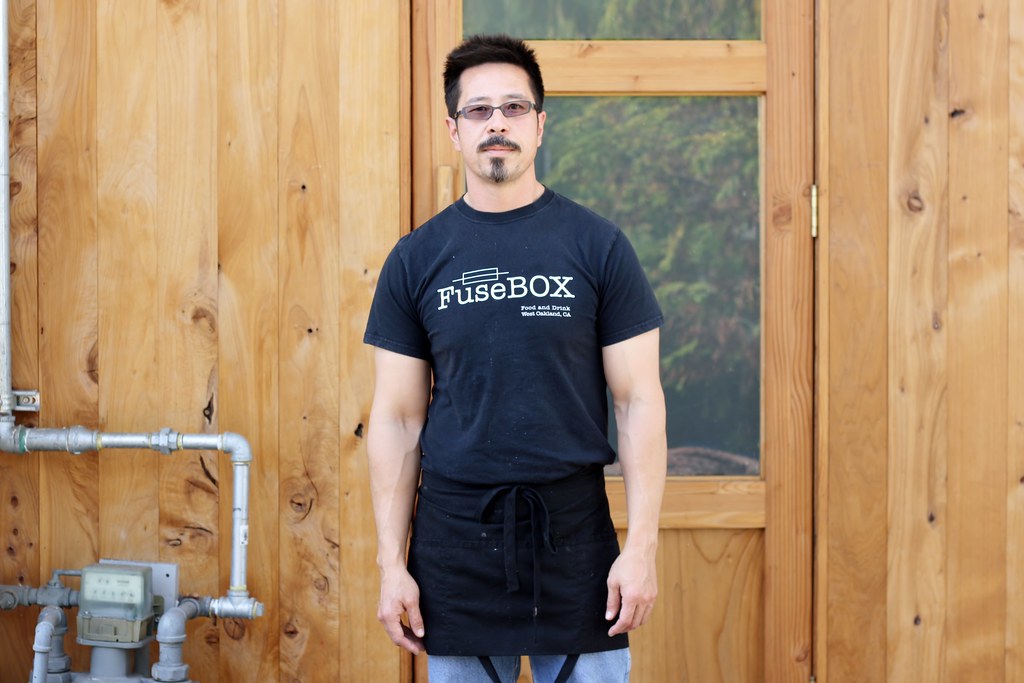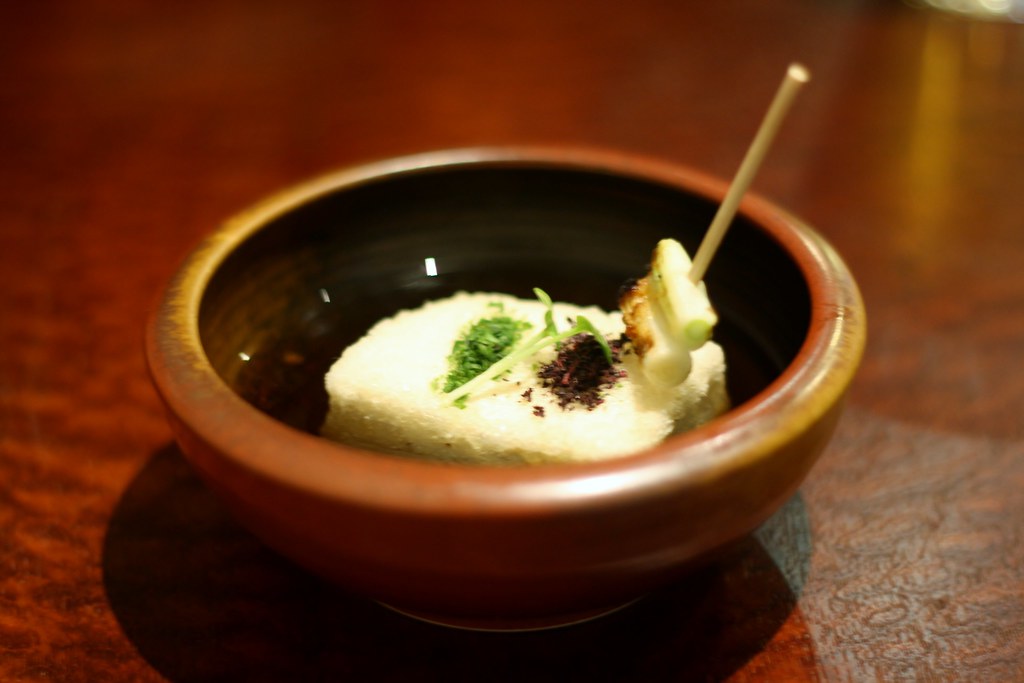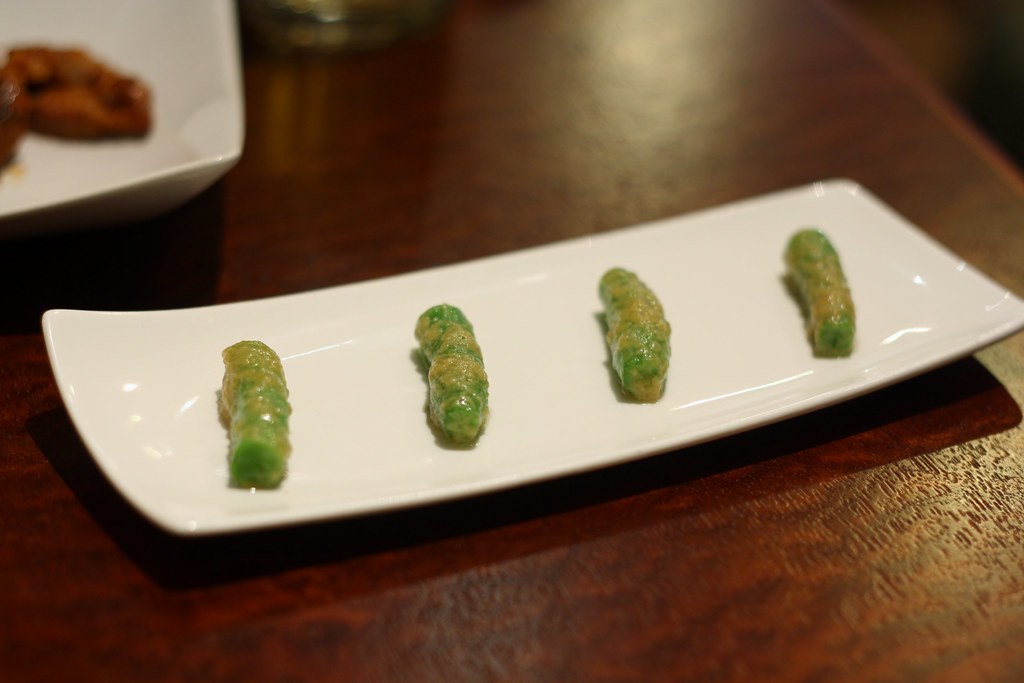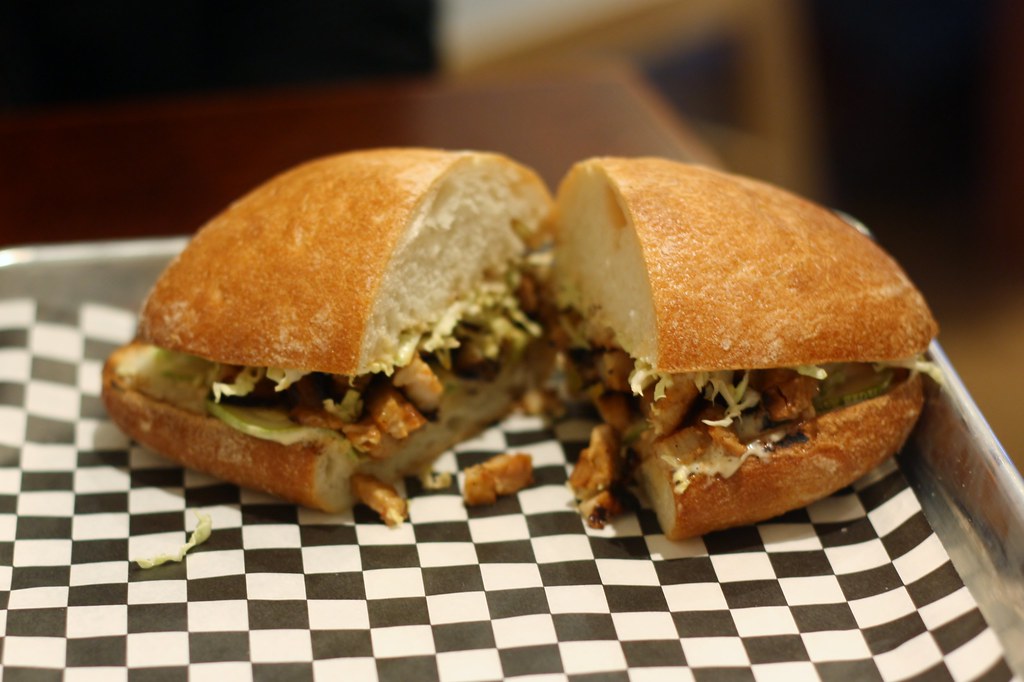It was a mid-September weekend. Like many weekends to come, I dragged a couple of friends across the Bay Bridge to explore Urban Air Market, an indie craft fair in San Francisco's Hayes Valley. Being the multitasking blogging machine that I am, I had an ulterior motive to snap a few photos along the way, resulting in Exhibit A, Exhibit B, and Exhibit C. As my friends scoured through the offline Etsy and I did my rounds scouring the crowd scouring Etsy, I passed by a booth that caught my fancy. Reuben of Famous Four Colors was giving out free cake pops.
Being a seasoned follower of food blogs as well as an occasional Starbucks patron and display case detective, I knew these things were popular and at least worth a try. I asked Reuben what I had to do to get a dessert chunk in my possession and to my delight, I just had to fill out a short survey. Let me assure you: this was not one of those "WIN A FREE iPHONE SURVEY NOW NOW NOW!!1!" nuisances you used to come across on pirated TV sites three years ago. No, this survey was actually short and kind of fun. (I have a slight penchant for filling out forms.) I filled it out, got not one but two cake pops (I should be in business, just sayin'), and touched one of the softest tees I've ever encountered.
This last part was unexpected. After gingerly devouring the stick treats, I realized that there was a booth attached to this cake pop distribution center and it went by the name of Famous Four Colors. Reuben Barnes-Levering started this downtown Oakland-based organic clothing company as well as its custom screen printing brother brand, Umbrella Shirts. After being rather impressed by the clever designs on the angel-soft tees and the fact that they hailed from Oakland on Webster just off Broadway, I knew there was more to explore. Reuben gave me the opportunity to thoroughly pick his brain and tour their headquarters. Without further delay, here's how the screen printing king does it one shirt at a time.
Brittany: Like many entrepreneurs,
you discovered your passion for designing t-shirts in high school and
eventually bought your own screen printing press. Can you describe how you transitioned
from working in your father’s garage to starting your own label, Famous Four
Colors?
Reuben: One
track mind! Seriously. Just kept my head down and kept working on the same
project… of course, making adjustments over the years to the game plan. But
what I have now is essentially what I was working for when I first started.
Brittany: Have you always been
interested in pursuing a creative field or being an entrepreneur?
Reuben: Yes.
I originally wanted to go to school for graphic design but could not get in a
program for that. I really never saw myself working for anyone else long-term,
not to say it's not an option, but I just never pictured it.
Brittany: What are some of the
adjustments you made over the years that have culminated in what Famous Four
Colors is today?
Reuben: I
think that most of the adjustments are internal. I think that when you get
older, more knowledgeable, more experienced, more healthy (less drunk!), you
begin to shift your perspective of how to achieve what you want to achieve and
also what your vision is. For example, if I were to start a restaurant today I
would not be starting at the same place I started my screen printing company, which
was a little hole in the wall one-man operation, ducking and dodging regulators,
hiring friends under-the-table part-time and partying constantly!
Brittany: So, basically your
company evolved with you.
Reuben: Is
evolving.
Brittany: What are some ways it's
still growing?
Reuben: Well,
I think my ultimate goal is to have a cultural impact. To me, Famous Four
Colors is a reflection of the diverse new landscape of America: culturally
diverse, socially and environmentally conscious, and hyper-connected globally. So,
if you think about it in the terms of a personal evolution, that's an
interesting step that we must take. Many people think that they want cultural
success and the trappings that come with it, but they don't critically analyze
their life to see if they are open to that level of demand and critique from
the outside world! So, just like E-40 says, gotta stay Humble & Hungry.
 When I visited Famous Four Colors, I asked Reuben how exactly the screen printing process works. He said it's made up of a few components, such as these plastic tubes...
When I visited Famous Four Colors, I asked Reuben how exactly the screen printing process works. He said it's made up of a few components, such as these plastic tubes...
 Which look like this when opened up...
Which look like this when opened up...
 Some of these buckets of paint...
Some of these buckets of paint...
 A few of theses...
A few of theses...
 And finally a giant octopus of a machine with many arms for the many layers of color used in a given design.
And finally a giant octopus of a machine with many arms for the many layers of color used in a given design.
 After a couple of hours, you end up with some pretty rad pieces like this shirt and that shirt.
After a couple of hours, you end up with some pretty rad pieces like this shirt and that shirt.
 Boxes and boxes of custom designs, created under the Umbrella Shirts branch, are found throughout their work space.
Boxes and boxes of custom designs, created under the Umbrella Shirts branch, are found throughout their work space.
Brittany: What does a culturally
successful Famous Four Colors look like?
Reuben: You've
got all the hard questions, huh! That one is difficult and probably revealing! What
does my vision of our company's success look like? I would love an outpost in
France.
Brittany: Why France?
Reuben: Because
I came back from there this summer and Paris blew my mind. To me it's like a
huge San Francisco. Artisan, they really take living well seriously. Great
bread, cheese, wine… But
seriously, I would love to be a part of an organization that is in conversation
with popular culture (meaning that we are noticeable enough to be referenced),
but that retains its original message and backbone. Since we are a clothing
company, I think there is a certain level of sales you must achieve. But it's
also just about listening to the outside world, and what people are truly
talking about and what they truly want. As a producer of goods, it is very easy
to get caught up in our own messages (marketing, product, sales, whatever...).
Brittany: How would you go about retaining
Famous Four Color's backbone?
Reuben: I
think that a culturally successful Famous Four Colors is a company that
constantly reflects the true current of popular culture through our unique lens.
Our backbone is retained through living our values and holding each other
accountable to them.
Brittany: What sets Famous Four
Colors apart from countless other clothing lines? Is it the aesthetic, company ideals,
community involvement…?
Reuben: Doper
clothing.
Brittany: A given.
Reuben: Indeed.
You know, Brittany, I've been in the world of art and design for long enough
that I am aware that talent is everywhere. Many people have ideals. Community
is built in many ways, and most often not by people with money or companies but
by the humblest members. So, in that way I think what makes a company stands
apart is really just their unique combination of all of those and more: How we
interact with each other. How we interact with our customers. How we design.
Fabrics we choose. Our location, our vibe, our website, our value system. And
that's what I truly love about business. It's not about making money, but it's
like cooking the most complex dessert ever, that takes 10 years to bake! You
have to get each ingredient just right. And when you got it… boom! So, we're not quite there yet, but
I believe we are close. You'll know when we are!
 Pieces from a previous art show held in their gallery space are lined up along a wall.
Pieces from a previous art show held in their gallery space are lined up along a wall.
 I found this guy watching the action from afar. Please note his fur cape, full-length plaid piece, and industrial hoop earrings. Can you say "style icon"?!
I found this guy watching the action from afar. Please note his fur cape, full-length plaid piece, and industrial hoop earrings. Can you say "style icon"?!
Brittany: How will I know?
Reuben: Well,
I guess there won't be a literal boom, but figuratively!
Brittany: Bat signal?
Reuben: Oh
my god, I want an Umbrella bat signal so bad. I actually made an Umbrella
Batman shirt. We used to sell it as a part of our old line. That's what it had…
the SF skyline and then the Umbrella Bat Signal shining above it. I think I
have a few extra somewhere if you drop by our shop!
Brittany: I'm sure someone
in Oakland knows how to make an umbrella bat signal. A rogue artist, perhaps.
Speaking of artists… you’ve collaborated with many different artists in a range
of disciplines, including a New York tattoo artist, Oakland-based rap duo The
Coup, and Oakland graffiti artist Vogue. How do you go about picking who to
work with?
Reuben: We
run the artists that we choose through an assessment. How well they align with
our values, our history, our future, and our audience. I am really looking
forward to a scarf and blouse we have dropping next week from Joshua Mays, an
artist who recently relocated from the East Coast to Oakland.
Brittany: How would you describe
his artistic style?
Reuben: Futuristic
neo-soul-scapes.
Brittany: And that translates into
clothing how?
Reuben: You'll
see next Friday!
Brittany: Where do you
find inspiration for your own designs?
Reuben: At
my best, through the cultural reflection lens that I was talking to you about. At
my worst, by staring at a blank computer screen… ugh.
Brittany: If you had any materials
and tools at your disposal, what would your ideal article of clothing look
like?
Reuben: Materials
and tools… gosh, things are so scientific these days! I think just an amazingly
soft cotton-hemp blend and vibrant screen prints are all I need.
In case you forget where you are...
Brittany: Fair enough. How has
working in Oakland, and in the city’s downtown in particular, allowed Famous
Four Colors to prosper?
Reuben: Tough
question. I think the City is vibrant and blossoming, but so are so many other
urban centers. By the City I meant Oakland… my bad… The Town. It's not where you're
at, but where you're at… nah'mean? I love Oakland. Wouldn't trade it, I'll tell
you that much.
Brittany: What can we expect to see
from Famous Four Colors in the future?
Reuben: Ah!
The Future! Let's see… boom! Smoke & Mirrors! Lights, Cameras & Web
Apps! A super solid team of people contributing
creatively to society's myriad literal and figurative cloth.
Learn more about how their shirts are made:
Keep up with Famous Four Colors:








